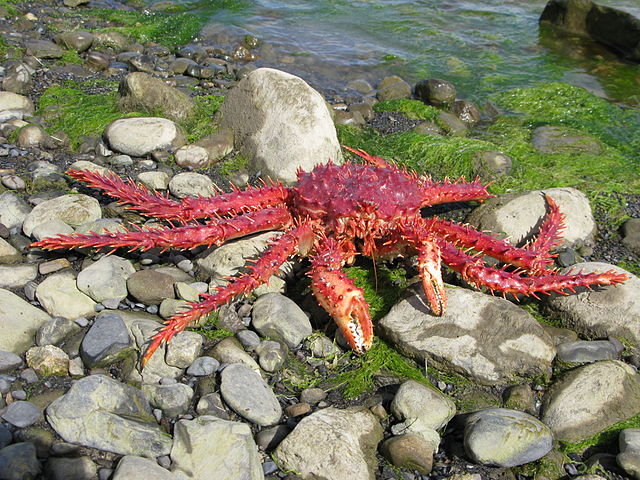Content deleted Content added
| (21 intermediate revisions by 6 users not shown) | |||
Line 2: {{Speciesbox | image = Lithodes.santolla.JPG | image_caption = Recently dead individual at [[Puerto Natales]], Chile | genus = Lithodes | species = santolla Line 11 ⟶ 12: }} '''''Lithodes santolla''''', also known as the '''southern king crab''', '''Chilean king crab''' or '''''centolla''''', is a [[species]] of [[king crab]], found off southern South America including the offshore [[Falkland Islands]].<ref name= == Physiology == ''L. santolla'' lives in cold-temperature and [[subantarctic]] waters. Ideal temperatures for its [[Crustacean larva|larval]] and juvenile development range from {{Convert|6 to 15|C|F|abbr=on}}, and its larval stages are nonfeeding.<ref name=":0" /> It experiences [[respiratory acidosis]] and [[hyperglycemia]] after prolonged exposure to air;<ref>{{Cite journal |last1=Schvezov |first1=Natasha |last2=Lovrich |first2=Gustavo A. |last3=Romero |first3=M. Carolina |date=March 2017 |title=Oxidatide stress during re-immersion of the king crab ''Lithodes santolla'' (Molina, 1782) (Decapoda Anomura: Lithodidae) after air exposure |journal=[[Journal of Crustacean Biology]] |volume=37 |issue=2 |pages=195–203 |doi=10.1093/jcbiol/rux004 |jstor=26792811 |doi-access=free}}</ref> however, these levels eventually return to normal after reimmersion, making it capable of withstanding long periods of aerial exposure with no detrimental effect on mortality.<ref>{{Cite journal |last1=Urbina |first1=Mauricio A. |last2=Paschke |first2=Kurt |last3=Gebauer |first3=Paulina |last4=Cumillaf |first4=Juan Pablo |last5=Rosas |first5=Carlos |date=December 2013 |title=Physiological responses of the southern king crab, ''Lithodes santolla'' (Decapoda: Lithodidae), to aerial exposure |journal=[[Comparative Biochemistry and Physiology Part A: Molecular & Integrative Physiology]] |volume=166 |issue=4 |pages=538–545 |doi=10.1016/j.cbpa.2013.08.006 |pmid=23973259}}</ref> == Fishing == [[File:Pesca de centolla en la Bahía Ushuaia 31.JPG|thumb|Fishing for ''L. santolla'' in [[Ushuaia]] Bay]] The population of ''Lithodes santolla'' has seen a dramatic decline due to commercial fishing.<ref name=":0">{{Cite journal |last1=Anger |first1=Klaus |last2=Lovrich |first2=Gustavo A. |last3=Thatje |first3=Sven |last4=Calcagno |first4=Javier A. |date=August 2004 |title=Larval and early juvenile development of ''Lithodes santolla'' (Molina, 1782) (Decapoda: Anomura: Lithodidae) reared at different temperatures in the laboratory |url=https://www.researchgate.net/publication/223835464 |journal=[[Journal of Experimental Marine Biology and Ecology]] |volume=306 |issue=2 |pages=217–230 |doi=10.1016/j.jembe.2004.01.010 |bibcode=2004JEMBE.306..217A |via=ResearchGate}}</ref> The lucrative centolla fishery around [[Tierra del Fuego]] led to an incident in August 1967 when the Argentine [[schooner]] ''{{lang|es|Cruz del Sur}}'' was found fishing {{convert|400|m}} from [[Gable Island]] and had to be escorted out of Chilean waters by the Chilean patrol boat ''{{lang|es|Marinero Fuentealba}}''.<ref>{{cite book |author1=Patricia Arancibia Clavel |author2=Francisco Bulnes Serrano |name-list-style=amp|year=2004 |title=La Escuadra En Acción: 1978: el conflicto Chile-Argentina visto a través de sus protagonistas |publisher=Maval Ltda |location=[[Santiago]] |isbn=956-258-211-6 |language=Spanish}}</ref> This event among many others led to the [[Beagle conflict|Beagle crisis]] in the late 1970s. The United States [[Food and Drug Administration]] lists the centolla crab and southern king crab as two separate species: ''Lithodes antarcticus'' and ''Lithodes santolla'' respectively.<ref>{{cite web|title=Seafood List|url=http://www.accessdata.fda.gov/scripts/SEARCH_SEAFOOD/index.cfm?other=complete|publisher=U.S. Food and Drug Administration |archive-url=https://web.archive.org/web/20130921190337/http://www.accessdata.fda.gov/scripts/SEARCH_SEAFOOD/index.cfm?other=complete |archive-date=21 September 2013 |url-status=dead}}</ref> Other sources consider ''Lithodes antarcticus'' to be a synonym of ''Lithodes santolla''.
==References== Line 24 ⟶ 31: ==External links== *{{Commons category-inline|Lithodes santolla|''Lithodes santolla''}} *{{Wiktionary-inline|centolla}} {{Lithodidae}} {{Taxonbar|from=Q2715536}} {{Authority control}} Line 30 ⟶ 39: [[Category:King crabs]] [[Category:Crustaceans of the eastern Pacific Ocean]] [[Category:Crabs of the Pacific Ocean]] [[Category:Western South American coastal fauna]] [[Category:Crustaceans described in 1782]] [[Category: [[Category: [[Category:Fauna of Tierra del Fuego]] | |||
 Article Images
Article Images